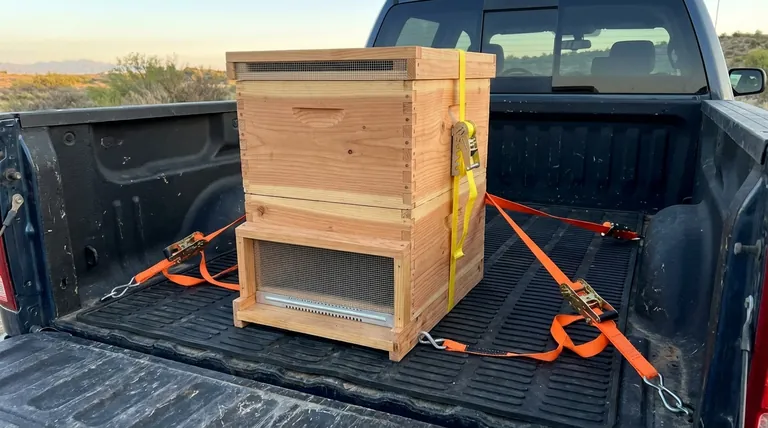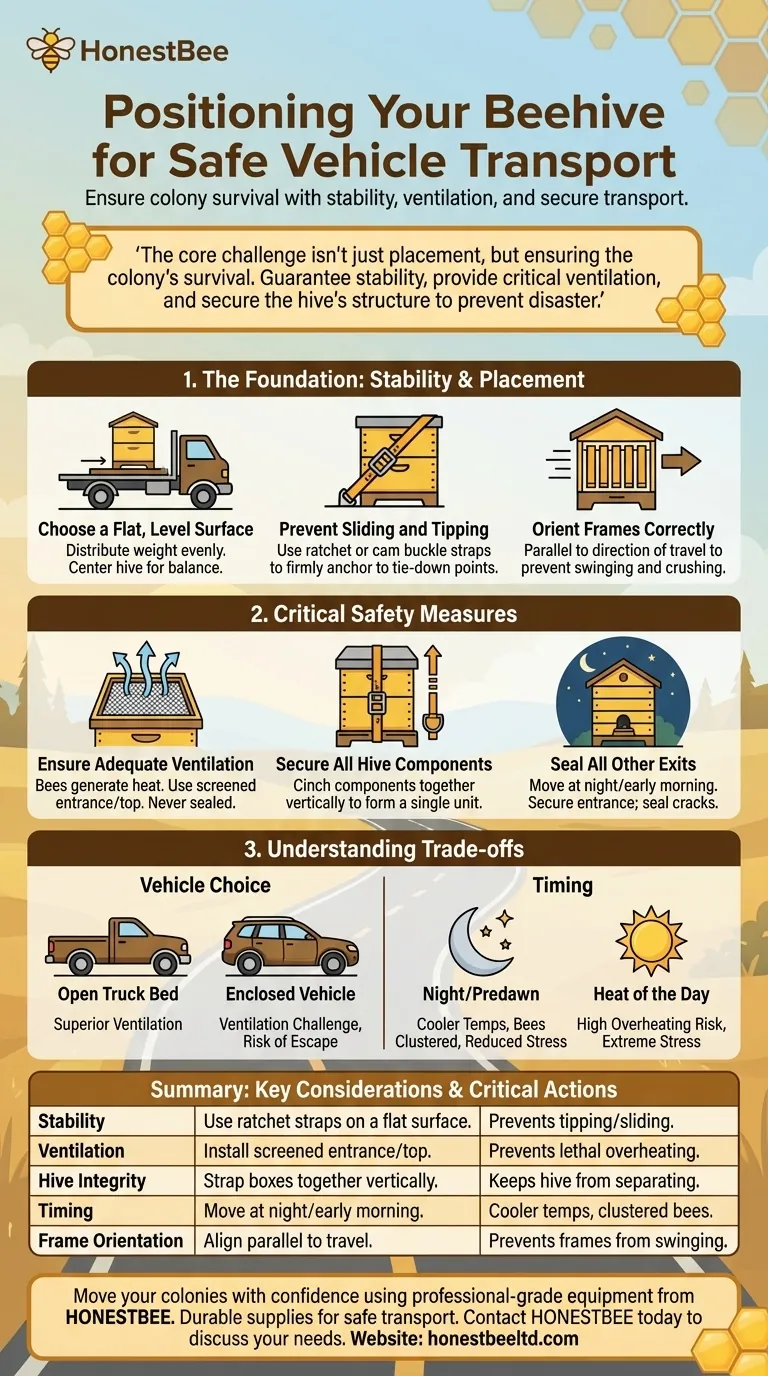To properly position a beehive in a vehicle, you must place it on a flat, stable surface where it can be secured against any movement. Using non-slip mats is a good first step, but you must also use straps to prevent the hive from sliding or tipping during transit, as a smooth, stable ride is critical to minimizing stress on the bees.
The core challenge of moving a hive isn't just its physical placement, but ensuring the colony's survival. Your primary goals are to guarantee stability, provide critical ventilation, and secure the hive's structure to prevent disaster during the journey.

The Foundation: Stability and Placement
How you position and secure the hive is the first step in a successful move. An unstable hive is a danger to both the bees and the driver.
Choose a Flat, Level Surface
A flat surface ensures the hive's weight is distributed evenly. This minimizes pressure on any single point of the hive body or the vehicle itself.
Positioning the hive in the center of a truck bed or cargo area helps maintain the vehicle's balance.
Prevent Sliding and Tipping
A non-slip mat is an excellent tool to reduce minor vibrations and prevent initial sliding. However, it is not sufficient on its own.
You must use ratchet straps or cam buckle straps to firmly anchor the hive to the vehicle's tie-down points. This prevents any tipping during turns or sudden stops.
Orient the Frames Correctly
Position the hive so the frames are parallel to the direction of travel. If they are perpendicular, braking and accelerating can cause the frames to swing like a pendulum, crushing bees and potentially damaging comb.
Beyond Placement: Critical Safety Measures
Simple placement is not enough. A hive is a living, breathing superorganism that requires specific conditions to survive transport.
Ensure Adequate Ventilation
Bees generate a significant amount of heat. In an enclosed, sealed hive, temperatures can rise to lethal levels in a very short time, killing the entire colony.
Use a screened entrance reducer or a screened moving top to allow for airflow while keeping the bees contained. Never transport a hive in a sealed car trunk or an unventilated cargo box.
Secure All Hive Components
A standard hive is just a stack of heavy boxes. Bumps in the road can easily cause them to shift or separate.
Use a separate ratchet strap to cinch the hive components together vertically, from the bottom board to the outer cover. This turns the stack of boxes into a single, solid unit.
Seal All Other Exits
Before moving, ensure every bee is inside. This is best accomplished by preparing the hive for moving at night or in the very early morning when the full foraging force has returned.
Secure the main entrance with a moving screen or block it with foam after all bees are inside. Check the hive body for any other cracks or holes and seal them with tape.
Understanding the Trade-offs: Vehicle and Timing
Your choice of vehicle and the time of the move have significant implications for the safety and stress levels of the colony.
Open vs. Enclosed Vehicles
A truck bed offers superior ventilation, which is the single biggest advantage for preventing overheating. However, it exposes the hive to the elements and provides less security against theft.
An SUV or van protects the hive from rain and wind but makes managing ventilation a critical challenge. You must ensure windows are cracked or that there is another source of fresh, cool air. The risk of bees escaping into the driver's cabin is also higher.
The Importance of Timing
Moving at night or predawn is the industry standard for a reason. The cooler ambient temperatures dramatically reduce the risk of overheating, and the bees are naturally clustered inside the hive, simplifying containment.
Moving during the heat of the day is extremely risky and stressful for the colony. It should be avoided unless it is an absolute emergency.
Making the Right Choice for a Successful Move
Your priorities will dictate your specific actions. A successful move is the direct result of methodical preparation.
- If your primary focus is colony survival: Prioritize ventilation above all else, and always strap the hive components together vertically.
- If your primary focus is driver safety: Double-check that all hive exits are sealed and that the entire hive is securely strapped to the vehicle itself.
- If you are moving a long distance: Plan for stops in shady areas to check your straps and monitor the hive for any signs of excessive heat or stress.
By treating the hive as a fragile, living system, you can ensure a safe and successful relocation for your colony.
Summary Table:
| Key Consideration | Critical Action | Why It Matters |
|---|---|---|
| Stability | Use ratchet straps on a flat surface. | Prevents tipping and sliding during transit. |
| Ventilation | Install a screened entrance or top. | Prevents lethal overheating of the colony. |
| Hive Integrity | Strap hive boxes together vertically. | Keeps the hive from separating into pieces. |
| Timing | Move at night or in the early morning. | Bees are clustered inside, and temperatures are cooler. |
| Frame Orientation | Align frames parallel to the direction of travel. | Prevents frames from swinging and crushing bees. |
Move your colonies with confidence using professional-grade equipment from HONESTBEE.
We understand that commercial apiaries and distributors need durable, reliable supplies for safe and efficient hive transport. From heavy-duty ratchet straps to screened ventilation tools, our wholesale-focused operations provide the equipment you need to protect your valuable investment.
Contact HONESTBEE today to discuss your beekeeping supply needs and ensure every move is a success.
Visual Guide

Related Products
- Professional Galvanized Hive Strap with Secure Locking Buckle for Beekeeping
- HONESTBEE Premium Italian Style Hive Tool with Hardwood Handle
- HONESTBEE Advanced Ergonomic Stainless Steel Hive Tool for Beekeeping
- Wholesales Dadant Size Wooden Bee Hives for Beekeeping
- Versatile Ratchet Hive Strap with S-Hooks for Secure Fastening
People Also Ask
- Why are hive straps important for beekeepers? Secure Your Hives Against Wind, Predators & Transport
- How should a cam buckle strap be installed for optimal performance? Master the Leverage for Maximum Tension
- What is the advantage of using cam buckle straps? Secure Your Load Fast with Simple, Safe Tensioning
- What maintenance is required for hive straps? A Guide to Cam Buckle vs. Ratchet Strap Care
- What is the best length for straps used around beehives? Why 12 Feet is the Industry Standard



















